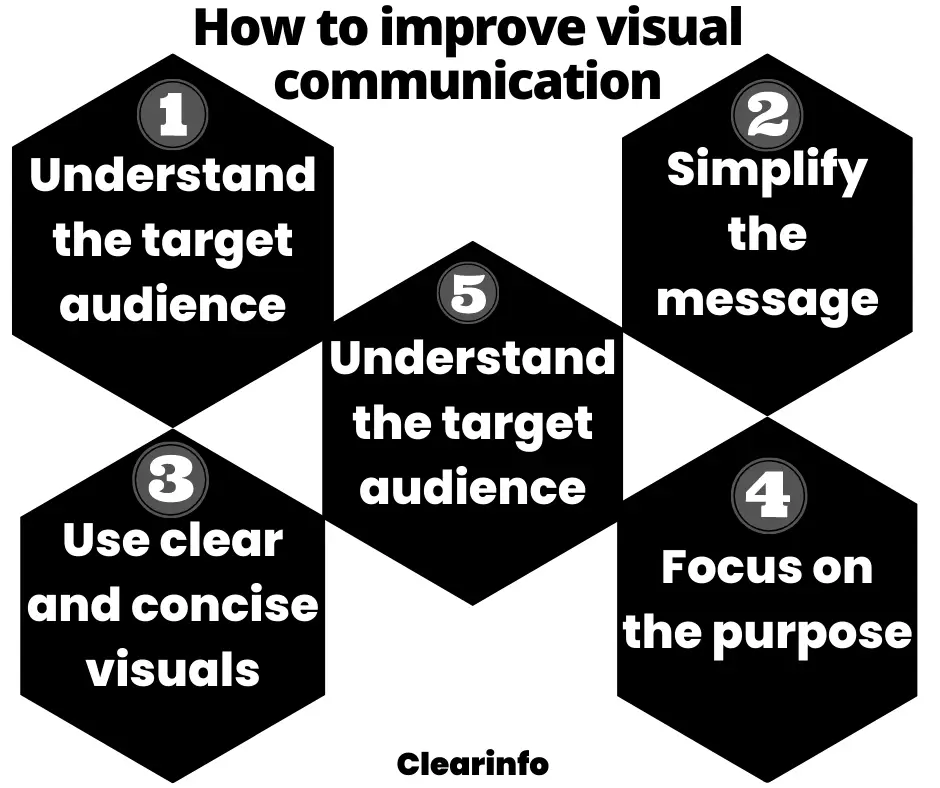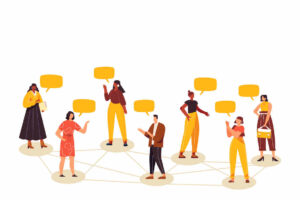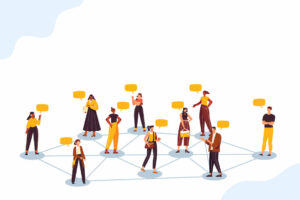In today’s world, visual communication has become an increasingly popular way to convey messages. Whether it’s through images, videos, or infographics, visuals can be a powerful tool in conveying information. However, like any communication method, there are also advantages and disadvantages to using visual communication. In this blog, we will explore the merits and demerits of visual communication and how to use it effectively.
What is visual communication?
Visual communication involves utilizing visual components to express ideas or information. This type of communication relies on visual aids such as images, graphics, videos, animations, and diagrams, to enhance the meaning and impact of a message
Visual communication can take many forms, including graphic design, professional picture editing, illustration, animation, and video. By combining visuals with text and other design elements, visual communication can create a dynamic and engaging user experience that can capture and hold the viewer’s attention.
The purpose of visual communication can range from providing information to persuading an audience, making it an essential aspect of marketing, advertising, and branding. Visual communication can be used across a variety of mediums, including print, digital, and social media, and the ability to convert image to video can enhance the impact of visual communication on these platforms.
Check out our detailed guide on: Visual Communication: Examples, Types, Elements & Importance
13 Advantages of disadvantages of visual communication?
Visual communication is a powerful communication channel that has been used to convey information, ideas, and emotions. In this context, it is important to weigh the pros and cons of visual communication to determine its effectiveness in a given situation.
Advantages of visual communication
1. Improved Comprehension: Visual communication can improve comprehension and understanding of complex information. By presenting information through visuals like diagrams, charts, and infographics, viewers can quickly and easily understand the information.
2. Increased Retention: Visuals are easier to remember and retain than text alone. This is because when information is presented in a visual format, it has a greater chance of being retained by individuals, resulting in better educational results.
3. Better Engagement: Using visuals in communication can be more captivating than relying solely on text. Human beings have an inherent inclination towards visual stimuli, and incorporating visual elements into your content can help to retain viewers’ attention for an extended period of time.
4. Increased Accessibility: Visual communication can make information more accessible to people with disabilities. For example, using captions and descriptive text with visuals can make them accessible to people with hearing or visual impairments.
5. Improved Clarity: Visuals can improve the clarity of your message. By using visuals to reinforce your message, you can ensure that viewers understand the point you’re trying to make.
6. Enhanced Emotional Connection: Visuals can create an emotional connection with viewers. By using visuals like images and videos, you can create a more powerful and emotional impact on your audience.
7. Improved Creativity: Visual communication can improve your creativity and imagination. By using visuals to express your ideas, you can come up with new and innovative ways to present information.
8. Increased Persuasiveness: Incorporating visuals in communication can be more effective in persuading the audience than relying solely on written or spoken words. Utilizing visuals to support the arguments, can present a more compelling and convincing case for the audience.
9. Better User Experience: Visuals can improve the user experience of your website or application. By using visuals like images and videos, you can create a more visually appealing and engaging experience for your users.
10. Increased Effectiveness: Visual communication can be more effective than text alone. By using visuals to support your message, you can increase the effectiveness of your communication and ensure that your message is received and understood by your audience.
11. Improving Brand identity: Visuals can be used to reinforce an identity of a brand. By using consistent visuals like color schemes, fonts, and logos, you can create a cohesive and recognizable brand image.
12. Increased Efficiency: Visual communication can be more efficient than text alone. By using visuals to convey information, you can communicate ideas more quickly and with less effort.
13. Improved Collaboration: Visual communication can improve collaboration between team members. By using visuals like diagrams and flowcharts, you can help team members better understand complex processes and work together more effectively.
Disadvantages of visual communication
1. Inability to Convey Emotion: Visual communication can be limited in its ability to convey emotions or tone of voice, which can be important in certain contexts. For example, written communication can be difficult to interpret without understanding the writer’s intent or tone of voice, and visual aids may not be able to convey this information accurately. Similarly, some people may be more comfortable expressing themselves orally, making visual communication less effective in these situations.
2. Limited Accessibility: One of the main disadvantages of visual communication is that it may not be accessible to people with certain disabilities. For example, Individuals having visual impairments will not be able to view or understand the visual message. Hence oral communication would be more suitable in these kinds of situations.
3. Misinterpretation: Visual communication can be subject to misinterpretation, as individuals may interpret visuals differently. In addition, It can be difficult to convey complex ideas or information using visual aids alone, which can lead to confusion or misunderstandings. This is particularly true when the visual aids are not well designed or organized, or when they are used in isolation from other forms of communication like oral or written communication.
4. Cultural Differences: Visuals may not be universally understood across different cultures. Symbols and images may have different meanings in different cultures, leading to misunderstandings and miscommunications.
5. Cost: Creating high-quality visuals can be costly and time-consuming, especially for businesses and organizations with limited resources.
6. Issue of Technological constraints: There may be certain technical limitations that could constrain the use of certain visuals. For example, some websites may not be able to display high-quality images or videos due to bandwidth limitations. In addition, technical constraints may also arise due to hardware and software limitations. Some older devices may not be compatible with certain image or video formats, which could affect the quality of the visuals.
7. Inaccurate Representations: Visuals may not always accurately represent the information they are intended to convey. This can happen because of problems such as data inaccuracies or biases which may lead to misleading conclusions.
8. Information Overload: Visual communication can also contribute to information overload. If too many visuals are used or if they are too complex, viewers may become overwhelmed and have difficulty processing the information.
9. Reliance on Technology: The use of technology plays a significant role in visual communication and it can be vulnerable to technical glitches and issues. This can disrupt communication and lead to frustration for viewers.
10. Ineffective for Certain Types of Information: Visual communication may not be the most effective way to convey certain types of information. For example, abstract concepts may be difficult to represent visually. Offen time complex or technical information may require written or oral communication to fully explain.
Related Reading:
11. Restricted Interaction: Visual communication may offer limited opportunities for interactivity compared to other forms of communication, such as written or verbal communication. This can limit the ability of viewers to ask questions or engage with the information presented.
12. Limited Persuasiveness: Visual communication may not be as persuasive as other forms of communication. While visual aids can be persuasive and influential in some situations, they may not have the same impact as oral or written communication, particularly when it comes to more complex or nuanced arguments. This can be a big disadvantage of visual communication in situations where persuasion is important, such as in sales or marketing.
Lack of Personal Connection: Visual communication can lack a personal connection between the communicator and the audience, particularly when compared to oral communication. This can be a disadvantage in situations where building trust and rapport is important, such as in interpersonal relationships or business negotiations.
Examples of visual communication
Visual communication can take many different forms and can be used in a variety of contexts. Here are some examples of visual communication:

1. Infographics: These are graphical representations of information or data that are designed to make complex information more easily understood.
2. Charts and graphs: Charts or graphs are graphical illustrations utilized to communicate patterns or connections within data or information.
3. Photographs: Photographs can be used to capture a moment or convey a mood or emotion.
4. Videos: Videos can be used to tell a story, demonstrate a process, or convey information.
5. Illustrations: Illustrations can be used to create a visual representation of an idea, concept, or story.
6. Logos and branding: Logos and branding can be used to visually represent a company or organization.
7. Signage: Signage can be used to convey information, such as directions or warnings, in a visual format.
8. Posters: Posters can be used to convey a message or market a product or concept.
9. Web design: Web design incorporates visual elements, such as graphics and layout, to create an effective online presence.
10. Packaging design: Packaging design incorporates visual elements, such as color and graphics, to create a product’s visual identity.
What is the importance of visual communication?
Effective transmission of information and messages heavily relies on visual communication. By using visuals, we can help audiences to comprehend information more easily, making it more likely that they will engage with and remember the message. Here are some key reasons why visual communication is important:
Firstly, visual communication can simplify complex ideas and make them easier to understand. They provide a quick and easy way to convey information and help the audience remember the message.
In addition, visual communication possesses a broad-based appeal that surpasses linguistic and cultural obstacles, making them an efficient channel for connecting with a vast audience.
Secondly, visual communication can evoke emotions and create a strong emotional impact. Images and videos have the power to elicit feelings and emotions in a way that text alone cannot. Creating an emotional bond of this nature can aid in developing confidence and cultivating a stronger relationship with the audience.
Lastly, visual communication can help businesses to improve the user experience by creating brand identity and recognition, making it easier for audiences to identify and remember a brand.
In summary, the importance of visual communication lies in its ability to simplify complex ideas, evoke emotions, and improve the overall user experience. It has become an essential tool for effective communication in a world where attention spans are short and information overload is prevalent.
Advantages and disadvantages of visual information
Visual information, such as images, videos, and infographics, has become increasingly prevalent in modern communication. However, like any other form of information, visual information has its own set of benefits and limitations.
Advantages of visual information
Improved comprehension and retention of information: Studies have shown that people remember visual information better than text alone, making it a valuable tool for communicating important information. By using visuals to break down complex ideas into digestible parts, we can help audiences to comprehend information more easily and retain it for longer periods of time.
Increased brand awareness and recognition: Visuals are an important tool for establishing brand identity and recognition. By using consistent visual elements such as logos, color schemes, and typography, businesses can create a distinct brand identity that is easily recognizable.
Improved accessibility: Visual information can be a more accessible way of conveying information for people with learning disabilities, as it can simplify complex ideas and make them more understandable. For example, infographics can help to convey information that may be difficult to understand in a traditional text-based format.
Disadvantages of visual information
High chance of misinterpretation: One disadvantage of visual information is that it can sometimes be misinterpreted or misunderstood. For example, a chart or graph may be interpreted in different ways depending on the audience’s background knowledge or perspective. This can lead to confusion or miscommunication.
Can be costly: Another disadvantage of visual information is that it can be time-consuming and expensive to create. High-quality visual information requires significant planning, design, and production time, which can be a challenge for organizations with limited resources.
Advantages and disadvantages of visual symbols
Visual symbols are a form of visual communication that use images or icons to represent ideas, concepts, or objects. Like any form of communication, visual symbols have both advantages and disadvantages.
The Advantage of visual symbols:
One of the main advantages of visual symbols is that they can be easily understood across different cultures and languages. Visual symbols can be universally recognized and do not require translation, making them a powerful tool for global communication. Additionally, visual symbols can convey complex ideas or concepts in a simple and memorable way, making them an effective tool for advertising and branding.
The disadvantage of visual symbols:
Visual symbols can be open to misinterpretation or ambiguity. Different people may interpret the same symbol in different ways, based on their background, cultural context, or personal experiences. This can lead to confusion or miscommunication, particularly if the symbol is used in a critical or sensitive context.
Advantages and disadvantages of audio-visual communication
Audio-visual communication refers to the use of audio and visual aids such as videos, animations, and presentations to convey information. However audio-visual communication has its importance and limitations.
Advantages of audio-visual communication:
- Increases audience engagement and interest.
- Helps convey complex information more effectively.
- Appeals to different learning styles.
- It is possible to utilize audio-visual communication to elicit emotions and generate a more memorable encounter.
- Can be more effective in delivering messages compared to text-only communication.
- Improves understanding and retention of information.
- Can be used to build brand recognition and enhance user experience.
- Enables real-time communication and feedback.
- Can be more efficient and cost-effective than in-person communication.
- They can be effortlessly circulated and disseminated through multiple platforms.
Disadvantages of audio-visual communication:
- Requires technical skills and equipment.
- Technical problems such as equipment failure or poor internet connectivity can have a negative impact.
- May not be accessible to individuals with hearing or visual impairments.
- May not be as effective in conveying complex or nuanced information as text-only communication.
- Can be time-consuming to produce and edit.
- Can be costly to produce high-quality audio-visual content.
- In many situations, it can be difficult to measure the effectiveness of audio-visual communication.
- May require additional resources for translation or localization.
- May not be appropriate for all audiences or contexts.
- Can be affected by cultural differences or misunderstandings.
What are the effects of visual communication?
Visual communication is a strong channel of communication that produces significant impacts on individuals and the entire society. One of the primary effects of visual communication is that it captures the audience’s attention and engages them.
By using a combination of design elements, such as color, typography, and imagery, visual communication can create a captivating experience that draws people in.
Another effect of visual communication is that it can also shape people’s perceptions and attitudes toward different ideas or products. By using various design elements and messaging, visual communication can create a specific brand image or evoke a certain emotion.
Finally, visual communication can have a significant impact on society as a whole. It can be used to create awareness around important issues, shape public opinion, and promote social change. By using visual communication effectively, individuals and organizations can bring attention to important social issues and promote positive change.
How can visual communication be improved?
Visual communication can be improved in several ways. Here are some tips to enhance the effectiveness of visual communication:

1. Understand the target audience: Before creating any visual communication, it is essential to understand the target audience’s needs, preferences, and expectations. This will help create visuals that resonate with them and improve engagement.
2. Simplify the message: Visual communication should be simple and easy to understand. Complex visuals can be confusing and turn off the audience. Simplifying the message ensures that the audience gets the point quickly.
3. Use clear and concise visuals: The visual elements should be clear, concise, and easy to read. Avoid using too many design elements or cluttered visuals that can confuse or overwhelm the audience.
4 Focus on the purpose: Visual communication should be created with a specific purpose in mind. The visual should be designed to achieve a specific goal, such as promoting a product or raising awareness for a cause.
5. Incorporate visual hierarchy: Visual hierarchy refers to the arrangement of visual elements in a way that guides the audience’s attention. Using a visual hierarchy ensures that the most critical information is highlighted and stands out.
Frequently Asked Question
Q1) What are the advantages and disadvantages of visual communication?
Ans: A crucial advantage of visual communication is that it is an effective way of conveying complex information quickly and efficiently. However, one of the main drawbacks to visual communication is that it can be open to interpretation and misinterpretation, as different people may interpret visual information differently.



